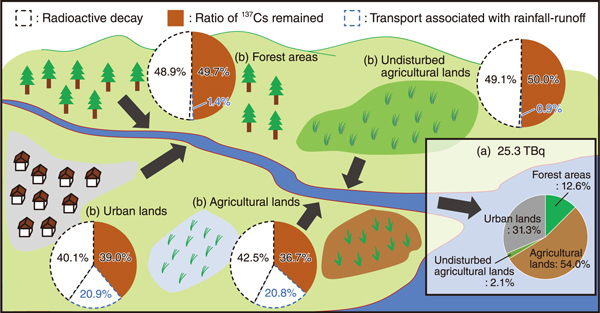
Fig.1 (a) The 137Cs transport into the ocean through the river in 30 years after the accident and the relative contribution of each land use category to the transport and (b) the ratio of 137Cs remained in each land use category after 30 years, and ratio of decrease in the 137Cs content on land
Most of the radiocesium (137Cs) deposited on land in the accident at TEPCO’s Fukushima Daiichi Nuclear Power Station (FDNPS) remains on land. The 137Cs deposited on land is transported into the ocean through rivers by rainfall-runoff. Therefore, predicting the long-term behavior of the 137Cs remaining on land and the 137Cs transported into the ocean is important to understand the long-term impacts of 137Cs on human health and the environment. Since the temporal trends of 137Cs transported by rainfall-runoff vary greatly depending on land use, it is essential to consider the characteristics of the 137Cs behavior in each land use category. Therefore, to reflect these characteristics, we developed a 137Cs prediction model that considers the behavior of 137Cs in soil and vegetation by land use.
We predicted 137Cs behavior in the Abukuma River basin, which is the largest river basin near FDNPS. This model can analyze the processes of water, soil, and 137Cs transport into the ocean through rivers by rainfall-runoff. Since no large-scale decontamination work was conducted in the target basin, the impact of the decontamination work was not considered. A comparison of the predicted results with monitoring data confirmed that the model reproduces the behaviors of 137Cs in land and river well. According to the prediction results, the 137Cs transported into the ocean through the river in 30 years after the accident is estimated to be 25.3 TBq (1 TBq = 1012 Bq) corresponding to 4.6% of the 137Cs deposited in the target basin. The contribution of the total transport from urban lands and agricultural lands corresponded to 85.3% of the total transport (Fig.1(a)). These results indicated that areas with human activities (urban lands and agricultural lands) contributed greatly to the 137Cs transport into the ocean. In the 30 years after the accident, 137Cs that was deposited in forest areas, undisturbed agricultural lands, urban lands, and agricultural lands was removed by rainfall-runoff by 1.4%, 0.9%, 20.9%, and 20.8%, respectively, and remained at 49.7%, 50.0%, 39.0%, and 36.7%, respectively (Fig.1(b)). Thus, the 137Cs remained in the areas with human activities decreased faster than that in areas without human activities (forest areas and undisturbed agricultural lands). These results suggested that human activities enhance the reduction of 137Cs remaining in land.
The predicted results of the long-term behavior of 137Cs in land provide useful information for evaluating future radiation exposure doses and the impacts of 137Cs on organisms. In future studies, the long-term prediction of 137Cs in basins near FDNPS will be conducted, considering the impact of human activities such as decontamination work.
This study was conducted as part of collaborative research with Osaka University.
(Tsubasa Ikenoue)